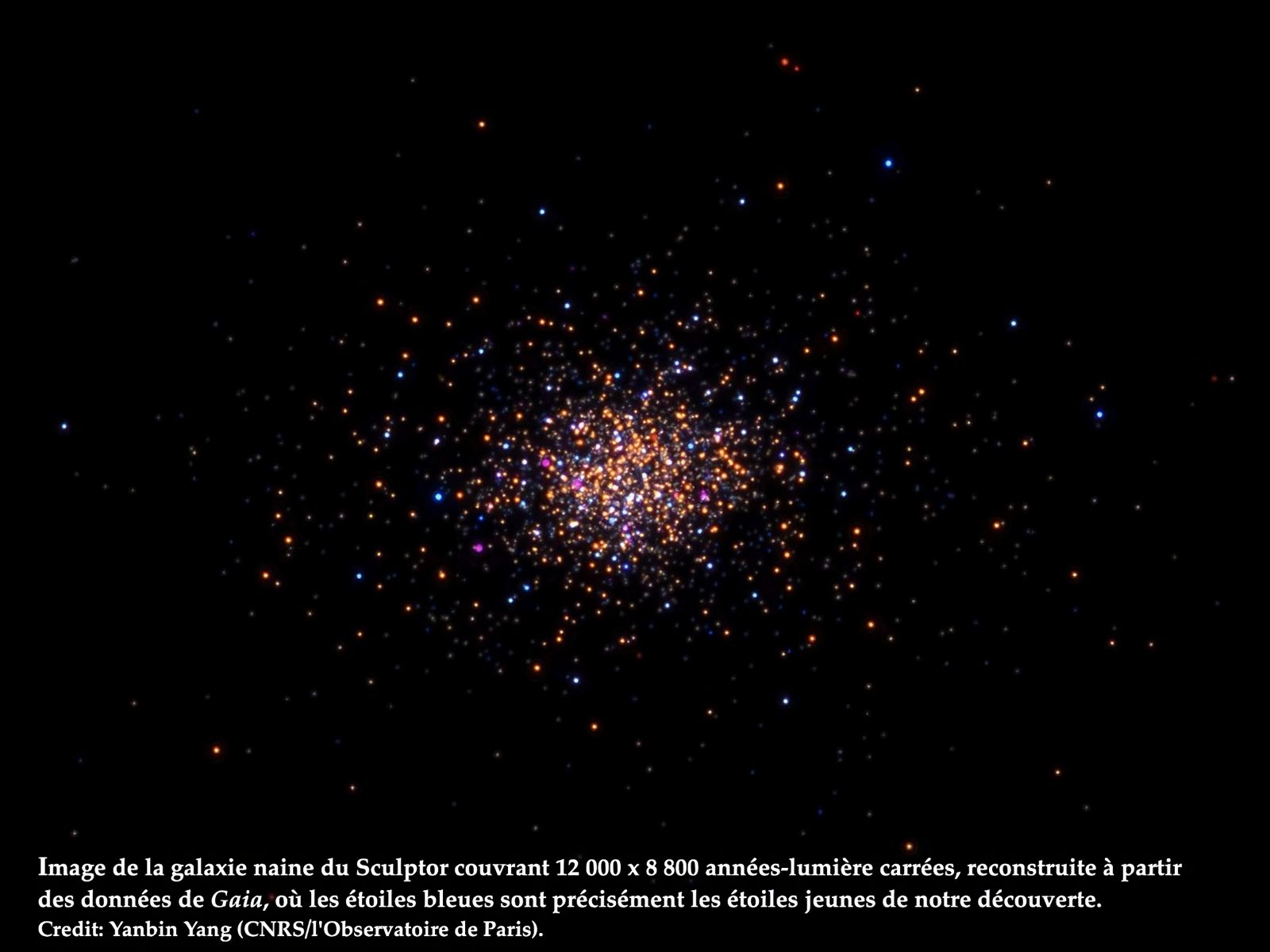Follow us on Google News (click on ☆)
This finding suggests that these dwarf galaxies retained gas until these recent epochs, allowing the formation of these new stars. Until now, it was believed that dwarf spheroidal galaxies had lost their gas 6 to 10 billion years ago, marking their entry into the vicinity of the Galaxy.

Image of the Sculptor dwarf galaxy covering 12,000 x 8,800 square light-years, reconstructed from Gaia data, where the blue stars are precisely the young stars identified in the discovery.
© Yabin Yang (CNRS / Paris Observatory)
The discovery of young stars suggests instead that these dwarf galaxies arrived less than 3 billion years ago, completely transforming the interpretation of their dynamics and dark matter content.
Over the last 30 years, astronomers have made significant efforts to observe and analyze the stellar populations of dwarf galaxies. Just over half of them are composed primarily of very old stars (6 to 10 billion years) with very low abundances of elements heavier than helium.
It was deduced that these dwarf galaxies, such as Sculptor, had lost their gas during these ancient epochs when they became satellites orbiting our Galaxy. This scenario had a major cosmological consequence: it required these galaxies to contain a significant amount of dark matter, whose role was to protect their stellar content, which would otherwise have been destroyed by the Milky Way's gravitational field and accompanying tidal effects.
The discovery of young stars in these dwarf galaxies disrupts this scenario. Indeed, since gas is required to form stars, the presence of young stars implies that these galaxies had gas as recently as 0.5 to 2 billion years ago. When accreted into the Milky Way's halo, gas-rich dwarf galaxies are stripped of their gas due to the dynamic pressure caused by the hot gas in the halo of our Galaxy. This process must be very rapid, given that the mass of dwarf galaxies is significantly lower than that of the Milky Way.
The discovery of young stars in dwarf spheroidal galaxies is the result of very detailed analysis of Gaia satellite data on the one hand, and photometric and spectral analyses performed with the VLT on the other. Thanks to Gaia, researchers literally “filtered” the stars belonging to the dwarf galaxies to exclude those of the halo of our Galaxy.
The efficiency of this filtering is unparalleled compared to anything done previously. Without Gaia, half of the stars observed in the field of view of the Sculptor dwarf galaxy would belong to our Galaxy. With Gaia, this contamination is reduced to just 1.4%!
This made it possible to clearly identify Sculptor's stars in the evolutionary phase corresponding to stars aged 0.5 to 2 billion years, with masses up to 3 solar masses. We know that sometimes stars "rejuvenate" by stealing mass from a companion, or even via mergers. However, to explain stars over two solar masses this way, one would have to invoke the merger of a triple system, an extremely rare event.
The simplest explanation is that these stars are genuinely young and not rejuvenated. The spectra of these stars confirm that their chemical composition matches that of other stars in Sculptor. Besides Sculptor, the dwarf galaxies Sextans, Ursa Minor, and Draco also show the presence of a young population, demonstrating that this phenomenon is fairly common among dwarf galaxies.
In this case, one must conclude that they lost their gas recently. This supports an alternative scenario for their origins, based on precise measurements of the orbits of dwarf galaxies obtained by the Gaia satellite. Dwarf spheroidal galaxies have orbital velocities two to three times higher than expected for ancient satellites of the Galaxy, which is consistent with a more recent arrival near the Galaxy, less than three billion years ago.
Numerical simulations predict that in this case, young stars should form in the same (low) proportion as is observed. The consequence is significant, as these models reproduce all the properties of dwarf spheroidal galaxies but with very little or even no dark matter.
References:
Yang et al., The accretion history of the Milky Way IV. Hints of recent star formation in Milky Way dwarf spheroidal galaxies, A&A, 691, A363 (2024).